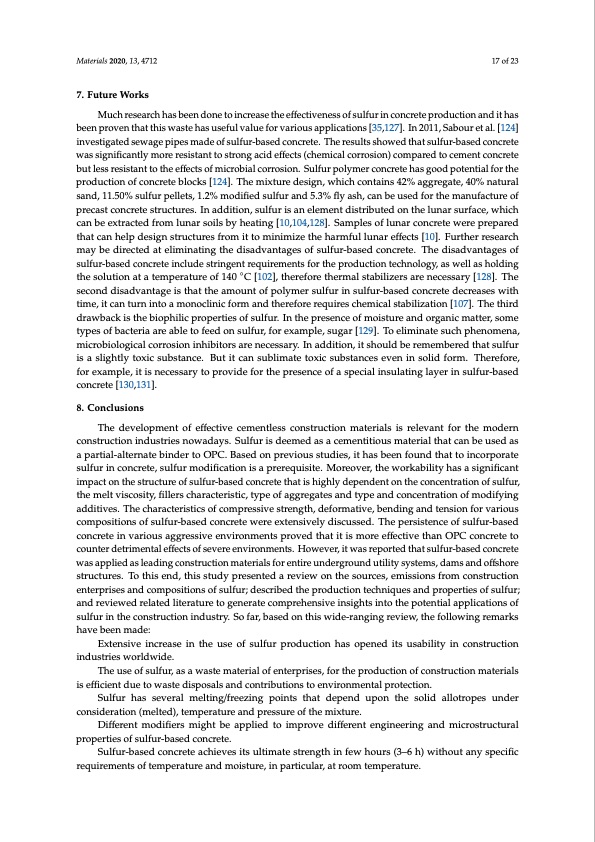
PDF Publication Title:
Text from PDF Page: 017
Materials 2020, 13, 4712 17 of 23 7. Future Works Much research has been done to increase the effectiveness of sulfur in concrete production and it has been proven that this waste has useful value for various applications [35,127]. In 2011, Sabour et al. [124] investigated sewage pipes made of sulfur-based concrete. The results showed that sulfur-based concrete was significantly more resistant to strong acid effects (chemical corrosion) compared to cement concrete but less resistant to the effects of microbial corrosion. Sulfur polymer concrete has good potential for the production of concrete blocks [124]. The mixture design, which contains 42% aggregate, 40% natural sand, 11.50% sulfur pellets, 1.2% modified sulfur and 5.3% fly ash, can be used for the manufacture of precast concrete structures. In addition, sulfur is an element distributed on the lunar surface, which can be extracted from lunar soils by heating [10,104,128]. Samples of lunar concrete were prepared that can help design structures from it to minimize the harmful lunar effects [10]. Further research may be directed at eliminating the disadvantages of sulfur-based concrete. The disadvantages of sulfur-based concrete include stringent requirements for the production technology, as well as holding the solution at a temperature of 140 ◦C [102], therefore thermal stabilizers are necessary [128]. The second disadvantage is that the amount of polymer sulfur in sulfur-based concrete decreases with time, it can turn into a monoclinic form and therefore requires chemical stabilization [107]. The third drawback is the biophilic properties of sulfur. In the presence of moisture and organic matter, some types of bacteria are able to feed on sulfur, for example, sugar [129]. To eliminate such phenomena, microbiological corrosion inhibitors are necessary. In addition, it should be remembered that sulfur is a slightly toxic substance. But it can sublimate toxic substances even in solid form. Therefore, for example, it is necessary to provide for the presence of a special insulating layer in sulfur-based concrete [130,131]. 8. Conclusions The development of effective cementless construction materials is relevant for the modern construction industries nowadays. Sulfur is deemed as a cementitious material that can be used as a partial-alternate binder to OPC. Based on previous studies, it has been found that to incorporate sulfur in concrete, sulfur modification is a prerequisite. Moreover, the workability has a significant impact on the structure of sulfur-based concrete that is highly dependent on the concentration of sulfur, the melt viscosity, fillers characteristic, type of aggregates and type and concentration of modifying additives. The characteristics of compressive strength, deformative, bending and tension for various compositions of sulfur-based concrete were extensively discussed. The persistence of sulfur-based concrete in various aggressive environments proved that it is more effective than OPC concrete to counter detrimental effects of severe environments. However, it was reported that sulfur-based concrete was applied as leading construction materials for entire underground utility systems, dams and offshore structures. To this end, this study presented a review on the sources, emissions from construction enterprises and compositions of sulfur; described the production techniques and properties of sulfur; and reviewed related literature to generate comprehensive insights into the potential applications of sulfur in the construction industry. So far, based on this wide-ranging review, the following remarks have been made: Extensive increase in the use of sulfur production has opened its usability in construction industries worldwide. The use of sulfur, as a waste material of enterprises, for the production of construction materials is efficient due to waste disposals and contributions to environmental protection. Sulfur has several melting/freezing points that depend upon the solid allotropes under consideration (melted), temperature and pressure of the mixture. Different modifiers might be applied to improve different engineering and microstructural properties of sulfur-based concrete. Sulfur-based concrete achieves its ultimate strength in few hours (3–6 h) without any specific requirements of temperature and moisture, in particular, at room temperature.PDF Image | Critical Review on the Properties and Applications of Sulfur-Based Concrete

PDF Search Title:
Critical Review on the Properties and Applications of Sulfur-Based ConcreteOriginal File Name Searched:
materials-13-04712.pdfDIY PDF Search: Google It | Yahoo | Bing
Sulfur Deposition on Carbon Nanofibers using Supercritical CO2 Sulfur Deposition on Carbon Nanofibers using Supercritical CO2. Gamma sulfur also known as mother of pearl sulfur and nacreous sulfur... More Info
CO2 Organic Rankine Cycle Experimenter Platform The supercritical CO2 phase change system is both a heat pump and organic rankine cycle which can be used for those purposes and as a supercritical extractor for advanced subcritical and supercritical extraction technology. Uses include producing nanoparticles, precious metal CO2 extraction, lithium battery recycling, and other applications... More Info
| CONTACT TEL: 608-238-6001 Email: greg@infinityturbine.com | RSS | AMP |